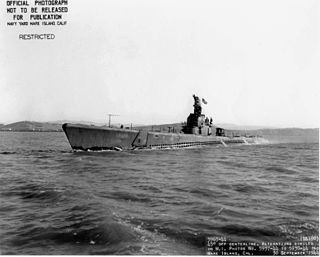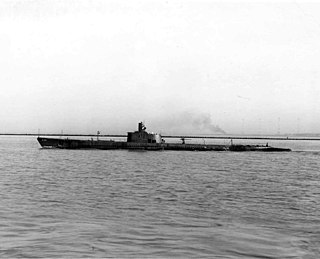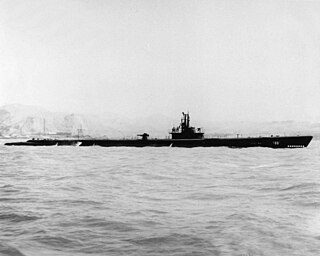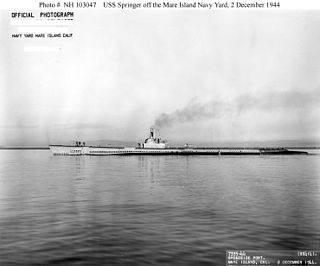
USS Gato (SS-212) was the lead ship of her class of submarine in the United States Navy. She was the first Navy ship named for the common name used for a number of species of catshark. She was commissioned only days after the declaration of war and made thirteen combat patrols during World War II. She survived the war and spent the post-war period as a training ship before being sold for scrapping in 1960.

USS Seawolf (SS-197), a Sargo-class submarine, was the second submarine of the United States Navy named for the seawolf.

USS Bonefish (SS-223) was a Gato-class submarine, the first United States Navy ship to be named for the bonefish.

USS Redfish (SS/AGSS-395), a Balao-class submarine, was the first ship of the United States Navy to be named for the redfish. In addition to her naval career, which included sinking the Japanese aircraft carrier Unryū, she made several film appearances in the 1950s.

USS Scamp (SS-277), a Gato-class submarine, was the first ship of the United States Navy to be named for the scamp grouper, a member of the family Serranidae.

USS Snook (SS-279), a Gato-class submarine, was the first ship of the United States Navy to be named for the common snook, an Atlantic marine fish that is bluish-gray above and silvery below a black lateral line.

USS Grayback (SS-208), a Tambor-class submarine, was the first ship of the United States Navy to be named for the lake herring, Coregonus artedi. She ranked 20th among all U.S. submarines in total tonnage sunk during World War II, with 63,835 tons, and 24th in number of ships sunk, with 14. She was sunk near Okinawa on 27 February 1944. Her wreck was discovered in June 2019.

USS Spearfish (SS-190), a Sargo-class submarine, was the only ship of the United States Navy to be named for the spearfish, any of several large, powerful, pelagic fishes of the genus Tetrapturus allied to the marlins and sailfishes.

USS Silversides (SS/AGSS-236) is a Gato-class submarine, the first ship of the United States Navy to be named for the silversides.

USS Scabbardfish (SS-397), a Balao-class submarine, was the only ship of the United States Navy to be named for the scabbarddfish, a long, compressed, silver-colored fish found on European coasts and around New Zealand. In 1965 she was transferred to the Hellenic Navy and renamed Triaina.

USS Greenling (SS-213), a Gato-class submarine, was the first ship of the United States Navy to be named for the greenling.

USS Lapon (SS-260), a Gato-class submarine, was the first ship of the United States Navy to be named after the lapon, a scorpionfish of the Pacific coast of the United States.

USS Pogy (SS-266), a Gato-class submarine, was the first ship of the United States Navy to be named for the pogy, or menhaden. She was credited with sinking 16 ships totaling 62,633 gross register tons during World War II.

The first USS Trepang (SS/AGSS-412) was a Balao-class submarine in the United States Navy. She was named after the trepang, an Indonesian name for a marine animal called a "sea slug" or a "sea cucumber," having a long, tough, muscular body and found in the coral reefs of the East Indies.

USS Seahorse (SS-304), a Balao-class submarine, was the first submarine and second ship of the United States Navy to be named for the seahorse, a small fish whose head and the fore part of its body suggest the head and neck of a horse.

USS Baya (SS/AGSS-318), a Balao-class submarine, was a ship of the United States Navy named for the baya. During World War II, she completed five war patrols in the South China Sea, Gulf of Siam, Java Sea, and Philippine Sea between 23 August 1944 and 25 July 1945. She sank four Japanese vessels totaling 8855 gross register tons, and shared credit with the submarine USS Hawkbill (SS-366) for sinking a Japanese 8,407-gross register ton passenger-cargo ship. After World War II, she saw service as a research submarine during the Cold War and operated off Vietnam during the Vietnam War.

The first USS Spadefish (SS/AGSS-411), a Balao-class submarine, was the first ship of the United States Navy to be named for the spadefish. Although she was commissioned late in the war and spent only one year in the Pacific war zone, she was able to run up a record of 88,091 tons in 21 ships and numerous trawlers sunk.

USS Hawkbill (SS-366), a Balao-class submarine, was the first ship of the United States Navy to be named for the hawksbill, a large sea turtle.

USS Pintado (SS-387/AGSS-387), a Balao-class submarine, was the first ship of the United States Navy to be named for the pintado.

USS Springer (SS-414) was a Balao-class submarine of the United States Navy, named after the springer, a Grampus.





















